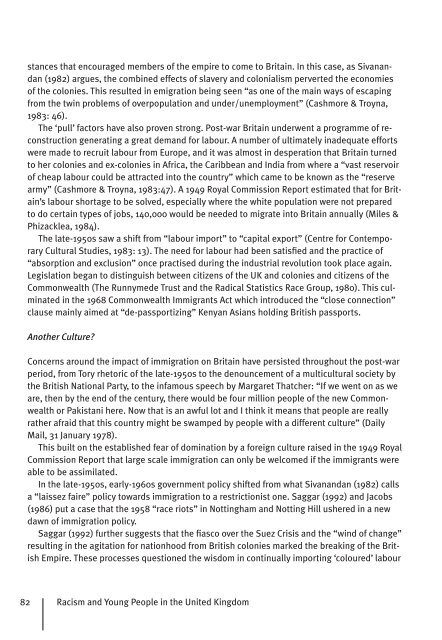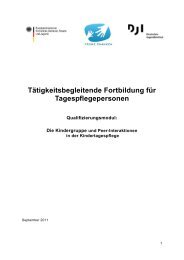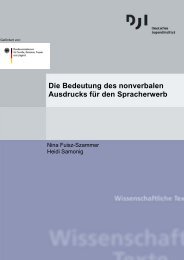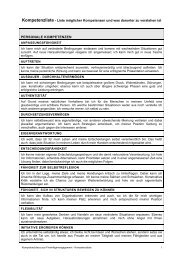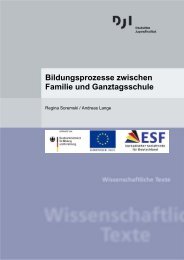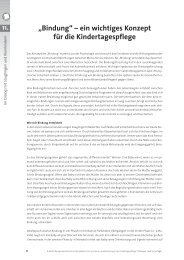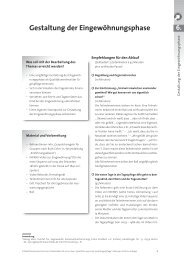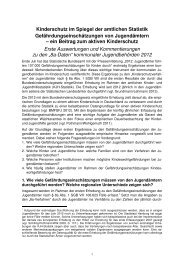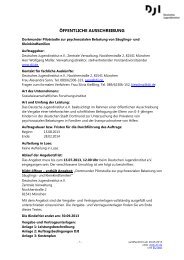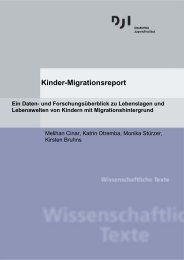Prevention of Right-Wing Extremism, Xenophobia and Racism in ...
Prevention of Right-Wing Extremism, Xenophobia and Racism in ...
Prevention of Right-Wing Extremism, Xenophobia and Racism in ...
Create successful ePaper yourself
Turn your PDF publications into a flip-book with our unique Google optimized e-Paper software.
stances that encouraged members <strong>of</strong> the empire to come to Brita<strong>in</strong>. In this case, as Sivanan-<br />
dan (1982) argues, the comb<strong>in</strong>ed effects <strong>of</strong> slavery <strong>and</strong> colonialism perverted the economies<br />
<strong>of</strong> the colonies. This resulted <strong>in</strong> emigration be<strong>in</strong>g seen “as one <strong>of</strong> the ma<strong>in</strong> ways <strong>of</strong> escap<strong>in</strong>g<br />
from the tw<strong>in</strong> problems <strong>of</strong> overpopulation <strong>and</strong> under/unemployment” (Cashmore & Troyna,<br />
1983: 46).<br />
The ‘pull’ factors have also proven strong. Post-war Brita<strong>in</strong> underwent a programme <strong>of</strong> rere- construction generat<strong>in</strong>g a great dem<strong>and</strong> for labour. A number <strong>of</strong> ultimately <strong>in</strong>adequate efforts<br />
were made to recruit labour from Europe, <strong>and</strong> it was almost <strong>in</strong> desperation that Brita<strong>in</strong> turned<br />
to her her colonies <strong>and</strong> ex-colonies <strong>in</strong> Africa, Africa, the Caribbean <strong>and</strong> India India from where a “vast reservoir<br />
<strong>of</strong> cheap labour labour could be attracted <strong>in</strong>to the country” which came to be known as the “reserve<br />
army” (Cashmore & Troyna, 1983:47). A 1949 Royal Commission Report estimated that for Brit-<br />
a<strong>in</strong>’s labour shortage to be solved, especially where the white population were not prepared<br />
to do do certa<strong>in</strong> types <strong>of</strong> jobs, 140,000 would be needed to migrate <strong>in</strong>to Brita<strong>in</strong> annually (Miles &<br />
Phizacklea, 1984).<br />
The late-1950s saw a shift from “labour import” to “capital export” (Centre for Contempo-<br />
Contempo-<br />
rary Cultural Studies, 1983: 13). The need for labour had been satisfi ed <strong>and</strong> the practice <strong>of</strong><br />
“absorption <strong>and</strong> exclusion” once practised dur<strong>in</strong>g the <strong>in</strong>dustrial revolution took place aga<strong>in</strong>.<br />
Legislation began to dist<strong>in</strong>guish between citizens <strong>of</strong> the UK <strong>and</strong> colonies <strong>and</strong> citizens <strong>of</strong> the<br />
Commonwealth (The Runnymede Trust <strong>and</strong> the Radical Statistics Race Group, 1980). This culcul- m<strong>in</strong>ated <strong>in</strong> the 1968 Commonwealth Immigrants Act which <strong>in</strong>troduced the “close connection”<br />
clause ma<strong>in</strong>ly aimed at “de-passportiz<strong>in</strong>g” Kenyan Asians hold<strong>in</strong>g British passports.<br />
Another Culture?<br />
Concerns around the impact <strong>of</strong> immigration on Brita<strong>in</strong> have persisted throughout the post-war<br />
period, from Tory rhetoric <strong>of</strong> the late-1950s to the denouncement <strong>of</strong> a multicultural society by<br />
the British National Party, to the <strong>in</strong>famous speech by Margaret Thatcher: “If we went on as we<br />
are, then by the end <strong>of</strong> the century, there would be four million people <strong>of</strong> the new Common-<br />
wealth or or Pakistani here. Now that is an awful lot <strong>and</strong> I th<strong>in</strong>k it means that people are really<br />
rather afraid that this country might be swamped by people with a different culture” (Daily<br />
Mail, 31 January 1978).<br />
This built on the established fear <strong>of</strong> dom<strong>in</strong>ation by a foreign culture raised <strong>in</strong> the 1949 Royal<br />
Commission Report that large scale immigration can only be welcomed if the immigrants were<br />
able to be assimilated.<br />
In the late-1950s, early-1960s government policy shifted from what Sivan<strong>and</strong>an (1982) calls<br />
a “laissez faire” policy towards immigration to a restrictionist one. Saggar (1992) <strong>and</strong> Jacobs<br />
(1986) put a case that the 1958 “race riots” <strong>in</strong> Nott<strong>in</strong>gham <strong>and</strong> Nott<strong>in</strong>g Hill ushered <strong>in</strong> a new<br />
dawn <strong>of</strong> immigration policy.<br />
Saggar (1992) further suggests that the fi asco over the Suez Crisis <strong>and</strong> the “w<strong>in</strong>d <strong>of</strong> change”<br />
result<strong>in</strong>g <strong>in</strong> the agitation for nationhood from British colonies marked the break<strong>in</strong>g <strong>of</strong> the Brit-<br />
ish Empire. These processes questioned the wisdom <strong>in</strong> cont<strong>in</strong>ually import<strong>in</strong>g ‘coloured’ labour<br />
82 <strong>Racism</strong> <strong>and</strong> Young People <strong>in</strong> the United K<strong>in</strong>gdom


